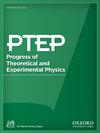世界卷 HMC 和广义顶针 HMC 的简化算法
IF 8.3
4区 物理与天体物理
Q1 Physics and Astronomy
引用次数: 0
摘要
世界卷混合蒙特卡洛法(WV-HMC 法)[arXiv:2012.08468] 是解决符号问题的一种可靠而通用的算法。与回火列氏顶针法类似,该方法消除了基于列氏顶针的算法固有的遍历性问题。除此以外,WV-HMC 方法还大大降低了计算成本,因为在生成配置时无需计算变形的雅各布。该方法的一个关键步骤是 RATTLE 算法,即在每个分子动力学步骤中使用牛顿法将传输构型投影到复数空间中的一个子实体(世界卷)上。在本文中,我们通过使用简化牛顿法(定点法)以及向量正交分解的迭代求解器来简化 RATTLE 算法,并证明该算法进一步降低了计算成本。我们还将此算法应用于广义顶针法的 HMC 算法(GT-HMC 法)。我们对简化 RATTLE 算法的收敛性进行了数值检验,结果表明收敛性对系统规模的依赖性很弱。这种简化算法在各种模型中的应用将在后续论文中报告。本文章由计算机程序翻译,如有差异,请以英文原文为准。
Simplified algorithm for the Worldvolume HMC and the Generalized-thimble HMC
The Worldvolume Hybrid Monte Carlo method (WV-HMC method) [arXiv:2012.08468] is a reliable and versatile algorithm towards solving the sign problem. Similarly to the tempered Lefschetz thimble method, this method removes the ergodicity problem inherent in algorithms based on Lefschetz thimbles. In addition to this advantage, the WV-HMC method significantly reduces the computational cost because one needs not compute the Jacobian of deformation in generating configurations. A crucial step in this method is the RATTLE algorithm, where the Newton method is used at each molecular dynamics step to project a transported configuration onto a submanifold (worldvolume) in the complex space. In this paper, we simplify the RATTLE algorithm by employing a simplified Newton method (the fixed-point method) along with iterative solvers for orthogonal decompositions of vectors, and show that this algorithm further reduces the computational cost. We also apply this algorithm to the HMC algorithm for the generalized thimble method (GT-HMC method). We perform a numerical test for the convergence of the simplified RATTLE algorithm, and show that the convergence depends on the system size only weakly. The application of this simplified algorithm to various models will be reported in subsequent papers.
求助全文
通过发布文献求助,成功后即可免费获取论文全文。
去求助
来源期刊

Progress of Theoretical and Experimental Physics
PHYSICS, MULTIDISCIPLINARY-PHYSICS, PARTICLES & FIELDS
CiteScore
12.00
自引率
5.70%
发文量
148
审稿时长
17 weeks
期刊介绍:
Progress of Theoretical and Experimental Physics (PTEP) is an international journal that publishes articles on theoretical and experimental physics. PTEP is a fully open access, online-only journal published by the Physical Society of Japan.
PTEP is the successor to Progress of Theoretical Physics (PTP), which terminated in December 2012 and merged into PTEP in January 2013.
PTP was founded in 1946 by Hideki Yukawa, the first Japanese Nobel Laureate. PTEP, the successor journal to PTP, has a broader scope than that of PTP covering both theoretical and experimental physics.
PTEP mainly covers areas including particles and fields, nuclear physics, astrophysics and cosmology, beam physics and instrumentation, and general and mathematical physics.
 求助内容:
求助内容: 应助结果提醒方式:
应助结果提醒方式:


